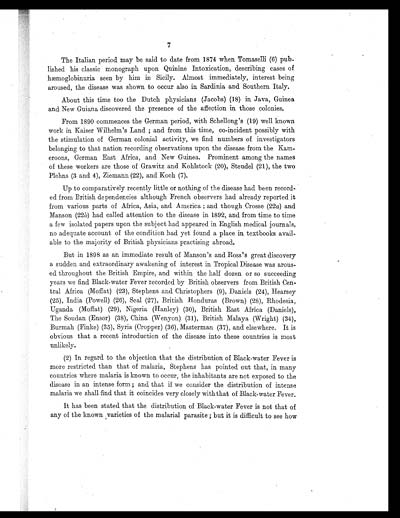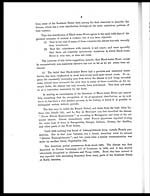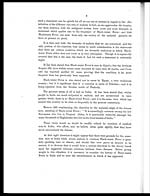Medicine - Institutions > Army health reports and medical documents > Scientific memoirs by officers of the Medical and Sanitary Departments of the Government of India > Number 35 - Black-water fever > Part I - Introductory
(19) Page 7
Download files
Individual page:
Thumbnail gallery: Grid view | List view

7
The Italian period may be said to date from 1874 when Tomaselli (6) pub-
lished his classic monograph upon Quinine Intoxication, describing cases of
hæmoglobinuria seen by him in Sicily. Almost immediately, interest being
aroused, the disease was shown to occur also in Sardinia and Southern Italy.
About this time too the Dutch physicians (Jacobs) (18) in Java, Guinea
and New Guiana discovered the presence of the affection in those colonies.
From 1890 commences the German period, with Schellong's (19) well known
work in Kaiser Wilhelm's Land; and from this time, co-incident possibly with
the stimulation of German colonial activity, we find numbers of investigators
belonging to that nation recording observations upon the disease from the Kam-
eroons, German East Africa, and New Guinea. Prominent among the names
of these workers are those of Grawitz and Kohlstock (20), Steudel (21), the two
Plehns (3 and 4), Ziemann (22), and Koch (7).
Up to comparatively recently little or nothing of the disease had been record-
ed from British dependencies although French observers had already reported it
from various parts of Africa, Asia, and America; and though Crosse (22a) and
Manson (22b) had called attention to the disease in 1892, and from time to time
a few isolated papers upon the subject had appeared in English medical journals,
no adequate account of the condition had yet found a place in textbooks avail-
able to the majority of British physicians practising abroad.
But in 1898 as an immediate result of Manson's and Ross's great discovery
a sudden and extraordinary awakening of interest in Tropical Disease was arous-
ed throughout the British Empire, and within the half dozen or so succeeding
years we find Black-water Fever recorded by British observers from British Cen-
tral Africa (Moffat) (23), Stephens and Christophers (9), Daniels (24), Hearsey
(25), India (Powell) (26), Seal (27), British Honduras (Brown) (28), Rhodesia,
Uganda (Moffat) (29), Nigeria (Hanley) (30), British East Africa (Daniels),
The Soudan (Ensor) (38), China (Wenyon) (31), British Malaya (Wright) (34),
Burmah (Finke) (35), Syria. (Cropper) (36), Masterman (37), and elsewhere. It is
obvious that a recent introduction of the disease into these countries is most
unlikely.
(2) In regard to the objection that the distribution of Black-water Fever is
more restricted than that of malaria, Stephens has pointed out that, in many
countries where malaria is known to occur, the inhabitants are not exposed to the
disease in an intense form; and that if we consider the distribution of intense
malaria we shall find that it coincides very closely with that of Black-water Fever.
It has been stated that the distribution of Black-water Fever is not that of
any of the known varieties of the malarial parasite; but it is difficult to see how
Set display mode to: Large image | Zoom image | Transcription
Images and transcriptions on this page, including medium image downloads, may be used under the Creative Commons Attribution 4.0 International Licence unless otherwise stated. ![]()
| Permanent URL | https://digital.nls.uk/75060293 |
|---|
| Shelfmark | IP/QB.10 |
|---|---|
| Additional NLS resources: | |




